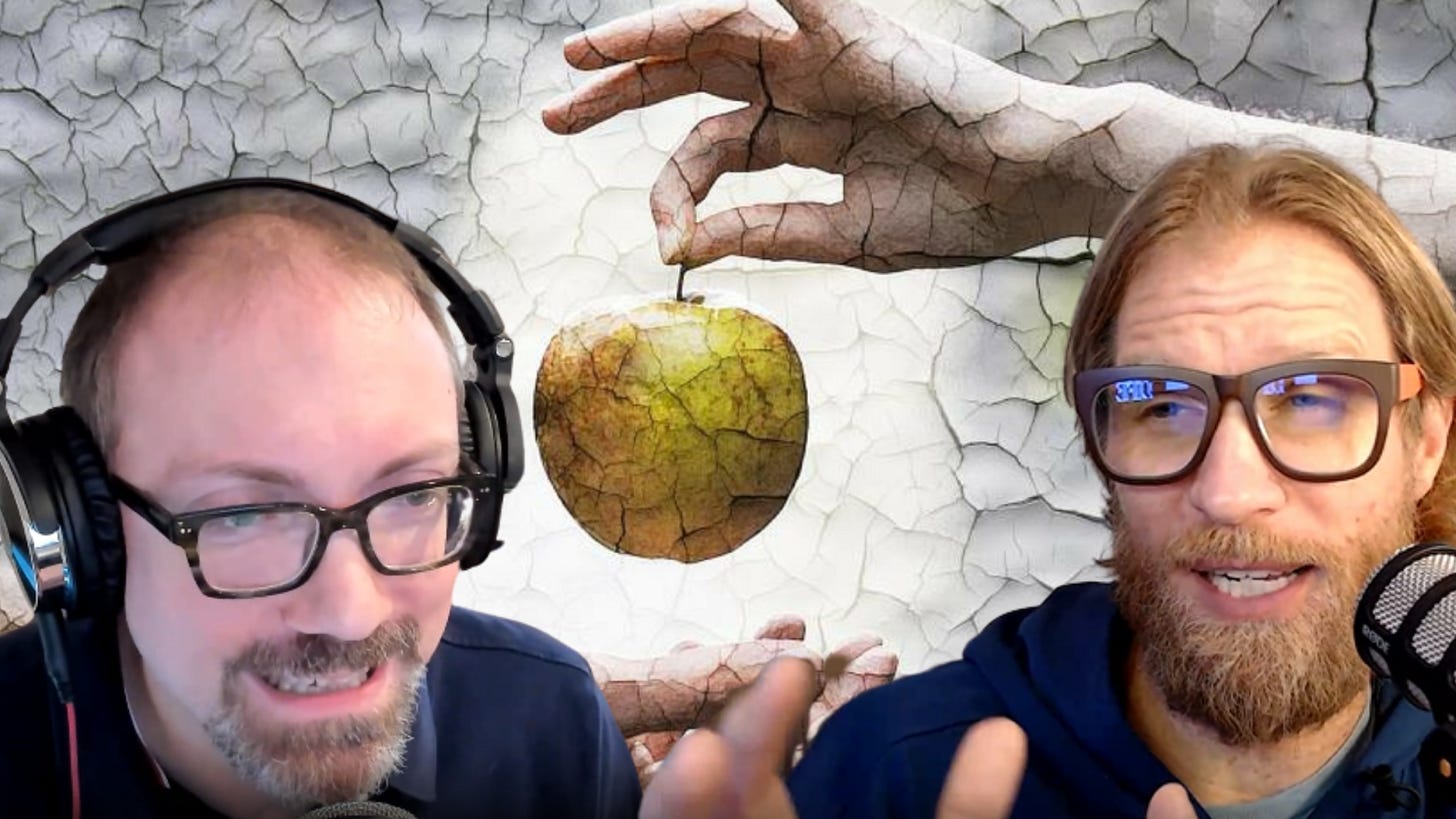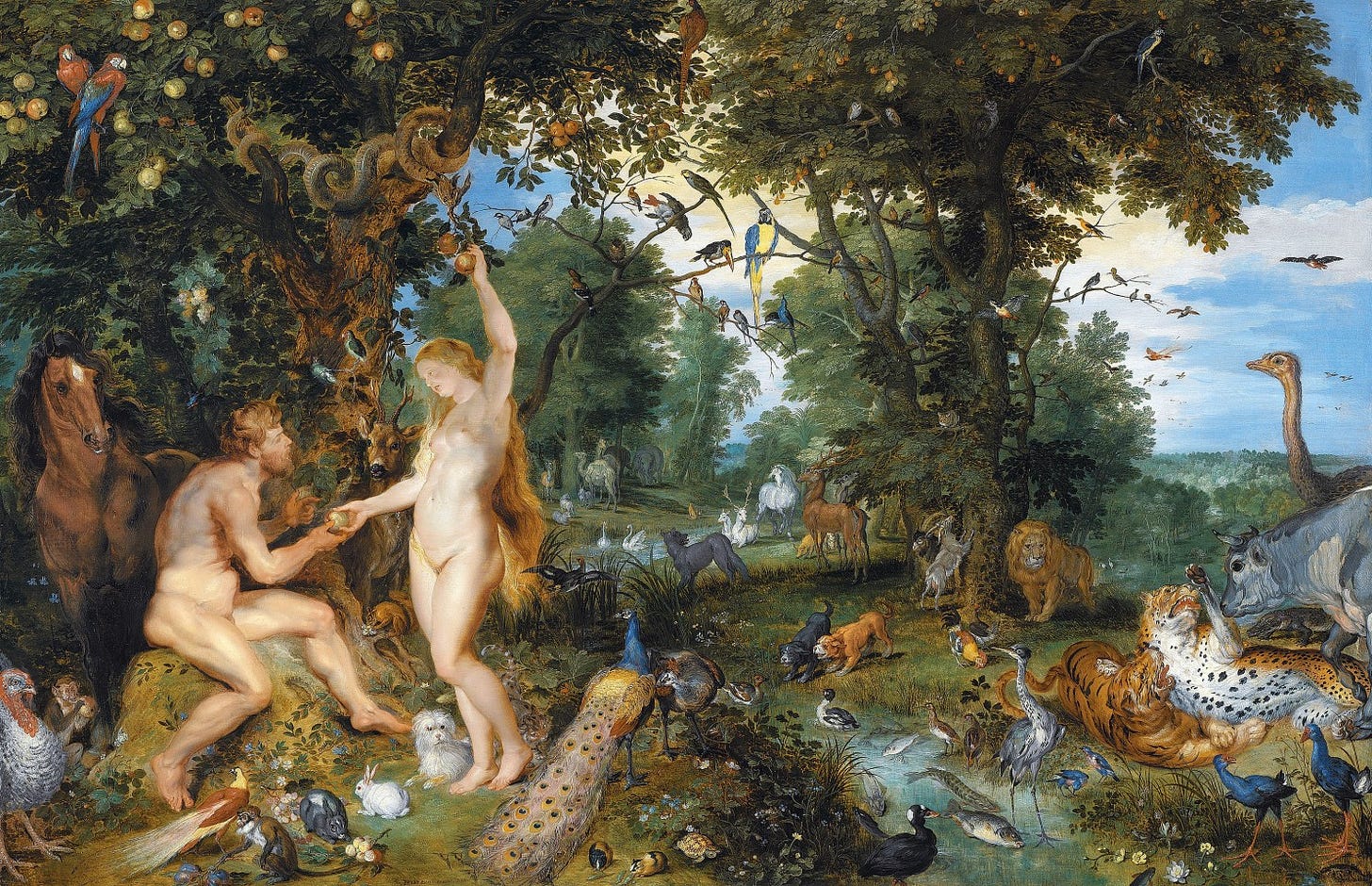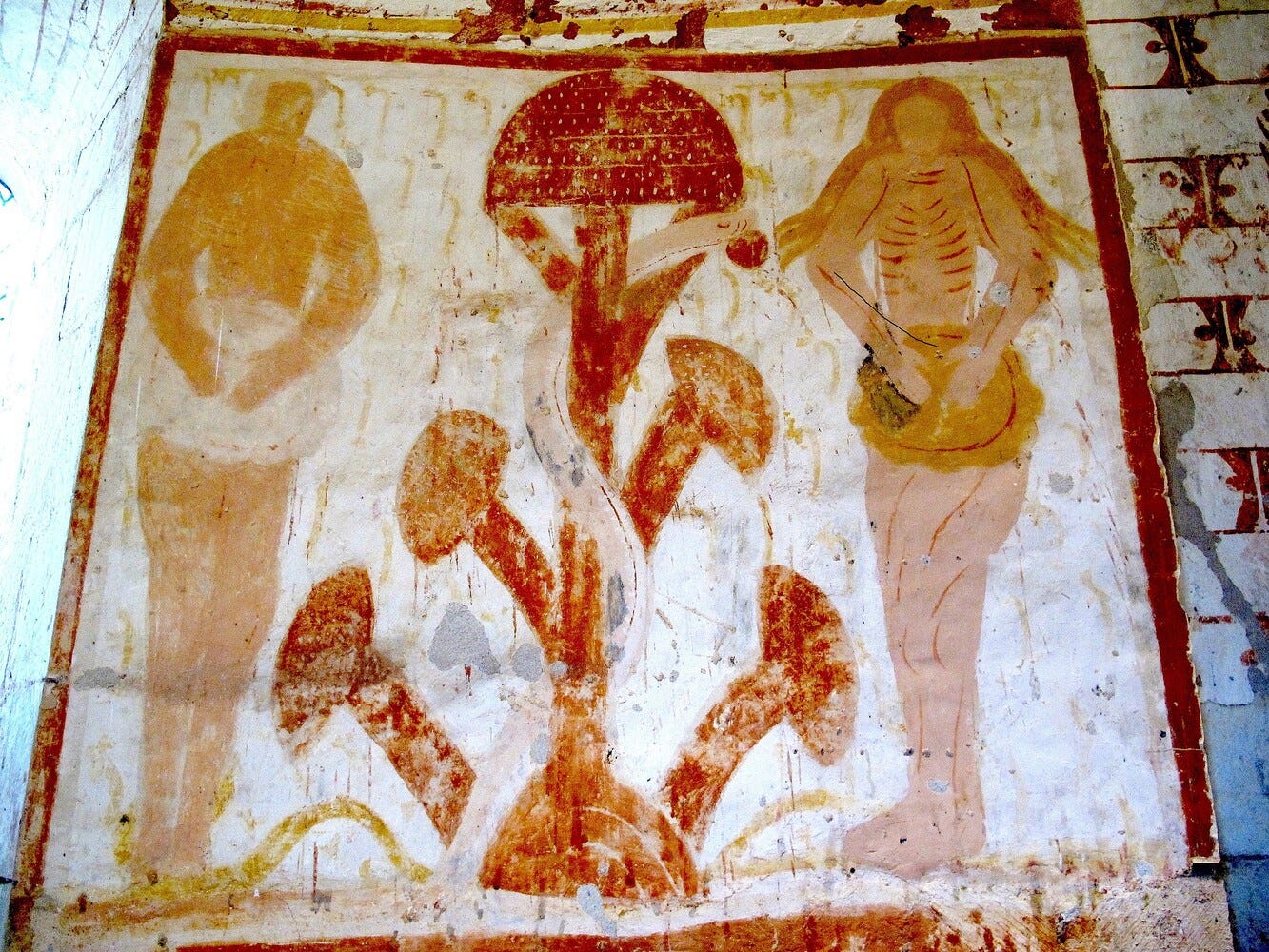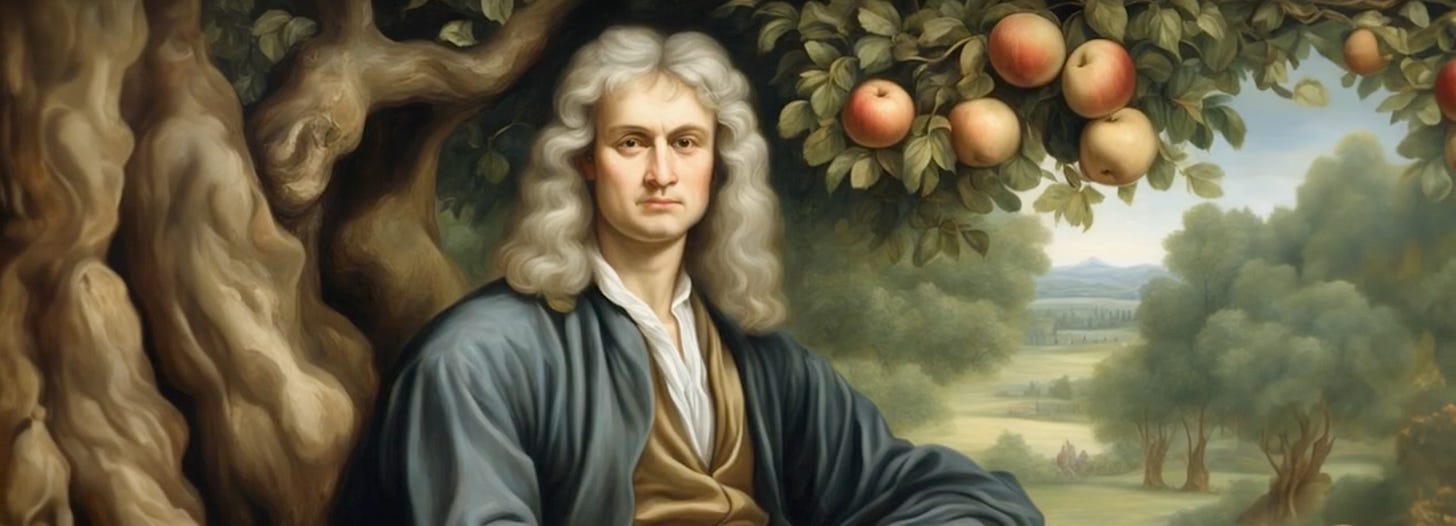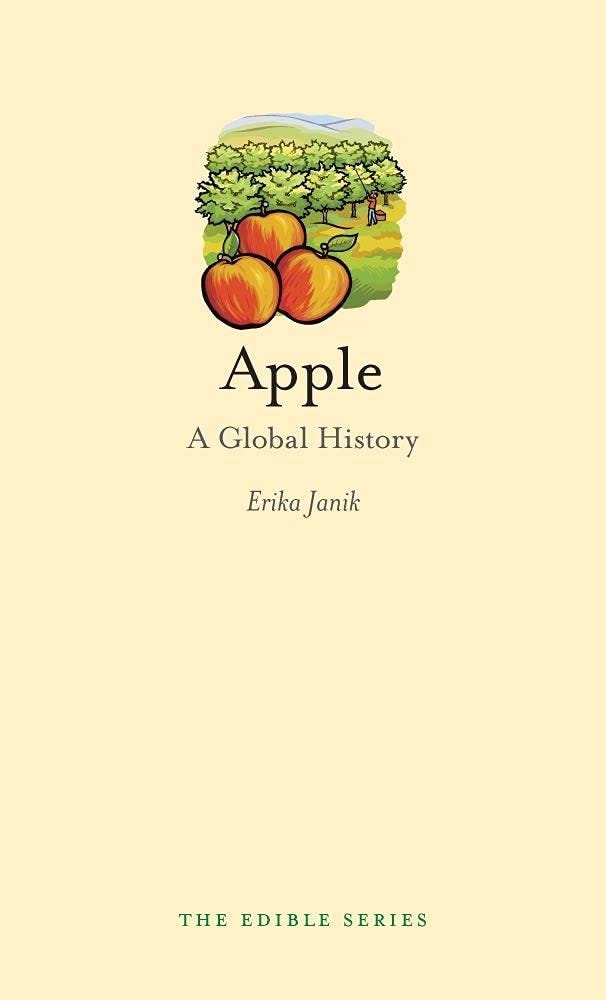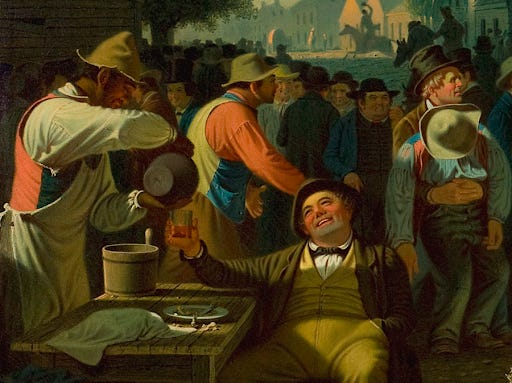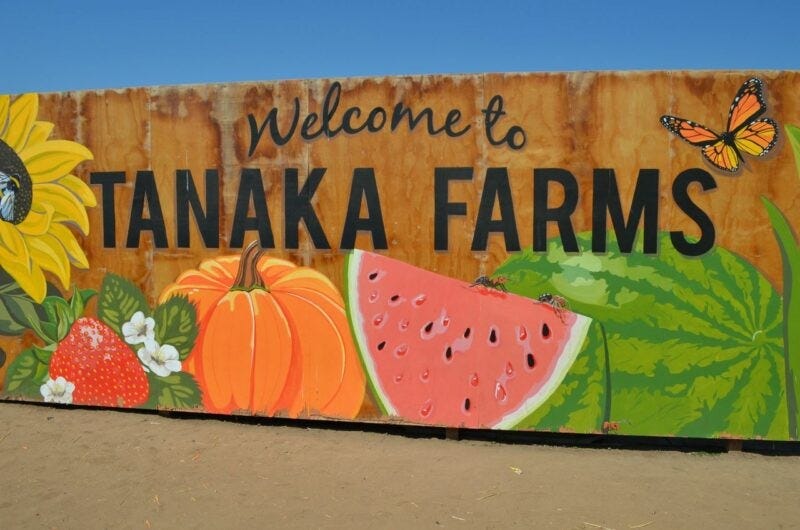Apples: Part 2
Will the real "forbidden fruit" please stand up? And the apple that changed the way we see the universe.
Happy Friday!
The apple adventure rolls on with two more captivating episodes from the past couple of weeks. John and Patrick explored the origins of some of the world’s most iconic apple names - while lamenting the underwhelming taste of the infamous Red Delicious. Then, they journeyed to the Renaissance, when the apple rose to fame as Britain’s patriotic fruit and became central to life in colonial America - where failing to brew a good cider was practically a public disgrace. Patrick, of course, worried what his own fate might’ve been, given his less-than-stellar Gatorade-making skills.
Now onto our extra stories, which this week features a mystery in the Garden of Eden and a hopeless farmer turned scientist.
Will the ‘real’ Forbidden Fruit please stand up?
In this week’s episode, we heard how the apple came to be known as the “forbidden fruit” of the Garden of Eden. As it turns out, the blame lies partly with a bit of Latin wordplay - and perhaps with people getting a little too carried away with their cider. But if the original fruit in the Garden wasn’t actually an apple… what was it? Historians, theologians, and botanists have proposed a few intriguing candidates:
Grapes
Grapes have long carried associations with temptation and indulgence. In the Zohar - a foundational text of Kabbalistic thought - it’s said that Noah planted grapevines after the flood to atone for the original sin committed with the forbidden fruit. The idea here is that wine, made from grapes, represented both the downfall and the potential redemption of humanity. Wine could bring joy and spiritual connection, but it could also lead to recklessness and moral failure. Given that the biblical Garden of Eden was thought to be located somewhere in the Mesopotamian region - where grapes were indeed cultivated as early as 6000 BCE - it’s plausible that the fruit Eve offered Adam could have been a grape or a cluster of them, symbolizing both knowledge and temptation through intoxication.
Figs
The fig is an obvious suspect. After all, it’s the very fruit Adam and Eve used for their first clothing: “And the eyes of them both were opened, and they knew that they were naked; and they sewed fig-leaves together, and made themselves girdles.” Figs have long symbolized fertility and female sexuality, which made them the “forbidden fruit” of choice during the Italian Renaissance. Michelangelo even painted the Tree of Knowledge as a fig tree on the Sistine Chapel ceiling. And given that figs are among the oldest cultivated fruits - native to the Middle East and West Asia - they fit the setting perfectly.
Pomegranates
Pomegranates are among the earliest domesticated fruits in the Middle East, making it entirely plausible that they could have grown in the fabled Garden of Eden. Beyond their ancient origins, these jewel-like fruits carry a deep and sometimes dark symbolism. In Greek mythology, the pomegranate is forever linked to the tale of Persephone, the daughter of Demeter, who was abducted by Hades, god of the underworld. When Persephone attempts to escape, Hades offers her a pomegranate. She eats just a few of its glistening seeds and in doing so, seals her fate. Because she has tasted the food of the underworld, she is condemned to spend part of each year there and the rest in the world above. From this myth, the pomegranate became a powerful symbol of temptation, entrapment, and the duality of life and death - a fruit both alluring and dangerous. It’s easy to see how such a fruit could have been imagined as the true “forbidden fruit” of Eden - one that offers knowledge, but at a price.
Mushrooms
This one stretches the imagination, but it’s not without intriguing hints of evidence. Some scholars and archaeologists have suggested that the biblical “Tree of Knowledge” could actually represent psychoactive mushrooms rather than a fruit-bearing tree. A 13th-century fresco in France’s Plaincourault Abbey seems to support this idea - it depicts what looks strikingly like a giant, mushroom-shaped tree, leading some to believe that early Christian artists may have associated mushrooms with divine or forbidden wisdom. Modern theorists have expanded on this idea, proposing that hallucinogenic fungi might have been the true “mind-opening fruit” of ancient myth - capable of expanding consciousness, altering perception, and offering profound insights that early humans could have interpreted as encounters with the divine. While mushrooms likely did not originate in the same region as the traditional Eden, the symbolic association between enlightenment and altered consciousness gives this theory a strange, mystical allure.
Bananas
This theory might sound a bit bananas, but since the 13th century, some scholars have indeed suggested that the forbidden fruit could have been - quite literally - a banana. In the writings of the 13th-century Sephardic philosopher Maimonides, the banana is even referred to as the “apple of Eden.” A few centuries later, in the 16th century, scholar Menahem Lonzano noted that it was widely accepted in Syria and Egypt that the banana was the very fruit eaten by Adam and Eve. It’s not hard to see why the idea caught on. The banana’s distinctive shape and smooth texture have long carried sensual connotations, easily linked to themes of temptation and desire that define the story of the Fall. However, there’s a major flaw in this theory: geography. As we’ve heard in an earlier episode, bananas originated in Southeast Asia, far from the region traditionally associated with the Garden of Eden. Still, the notion that the world’s most notorious act of temptation might have involved a banana adds an amusing twist to the centuries-old mystery of the true forbidden fruit.
So, what do you think? Was the forbidden fruit a fig, a grape, a pomegranate - or something far more unexpected?
For a fresh clearance every time!
J&K FRESH EAST is the industry leader in customs clearance and timely delivery of fresh produce, offering unmatched expertise, top-tier service, and flawless execution. With generations of deep family ties to the produce industry, the team at J&K Fresh has witnessed the evolution of produce logistics and possesses a thorough understanding of the challenges and solutions involved in safely bringing fresh produce into the United States.
Learn more about this impressive customs brokerage company here.
Newton’s Apple
There are a number of iconic moments in history where the humble apple has taken center stage: Adam and Eve’s fateful bite, William Tell’s legendary shot, Johnny Appleseed’s frontier wanderings - and, of course, Isaac Newton’s famous encounter with gravity. But did an apple really fall on Newton’s head? If so, what kind of apple was it? And is the tree still standing today?
Let’s set the scene. It’s the year 1666, and a 23-year-old Isaac Newton has retreated from Cambridge to his family’s farm, Woolsthorpe Manor, as the Great Plague sweeps through England. (That’s right - Newton was self-quarantining. Reminds you of the COVID years, doesn’t it?) There, amid the quiet countryside, he spends his days reading, experimenting, and, as one might imagine, pondering the mysteries of the universe. One afternoon, while wandering the orchard, Newton witnesses a simple yet profound event: an apple falls from a tree.
From that single observation, Newton began developing the ideas that would lead him to formulate the Universal Law of Gravitation. But did the apple hit his head while sitting under a tree? Not quite. According to Newton’s friend and early biographer, William Stukeley, Newton once recounted how the idea came to him - not through a blow to the head, but through observation.
As Stukeley wrote in his Memoirs of Sir Isaac Newton’s Life (1752):
“…he told me, he was just in the same situation, as when formerly, the notion of gravitation came into his mind. Why sh[oul]d that apple always descend perpendicularly to the ground, thought he to himself; occasion’d by the fall of an apple, as he sat in a contemplative mood…”
So, no - Newton wasn’t struck by a fruit from above. Rather, he witnessed the fall of an apple and began to wonder why it always dropped straight down, never sideways or upward. That simple question - why things fall as they do - set him on a path toward formulating one of the most transformative ideas in science: the Universal Law of Gravitation.
But that brings us to another fascinating question: what kind of apple inspired such cosmic thought? The answer lies at Woolsthorpe Manor itself. The property still contains what is believed to be Newton’s original apple tree - a claim supported by early sketches of the estate and even modern DNA analysis. The variety of apple growing on that tree is called the Flower of Kent, a large, greenish-red cooking apple. It’s not a particularly tasty fruit - mealy in texture, mild in flavor, and best suited for pies rather than snacking - but it’s now one of the most famous apple varieties in the world.
The original tree was brought down during a storm in 1816. But that wasn’t the end of Newton’s tree. From its fallen trunk, new shoots sprouted and grew, preserving its lineage. Today, the regenerated tree still stands proudly at Woolsthorpe, and grafted descendants of the same tree grow in scientific institutions and universities around the world.
What makes all this especially amusing is that Newton pursued a higher education partly because his mother thought he would be a hopeless farmer. Yet, despite escaping a life of agriculture, Newton’s greatest moment of insight - quite literally - sprang from an apple tree.
Become a leader in fresh produce
Whether you are a current student or a career professional, Cornell University’s Food Industry Management Program is the place to expand your knowledge and expertise in the fresh produce industry.
Learn more about this premier food education program here.
HFPC Book Deal
If you’re looking for some additional apple history to digest, Apple: A Global History by Erika Janik is a fantastic read. As a person who grew up surrounded by apples in Washington state, Janik makes for the perfect author to tell this fruit’s history.
But wait! If you’re a member of the History of Fresh Produce Club you can get this book at a DISCOUNT!
We partner with Books Are Magic, so that each week, HFP Club members can get either a 10% or 15% off books mentioned in the podcast. So, make sure to sign up today!
Fresh Merch
HONK if you love The History of Fresh Produce!
We’re thrilled to announce the launch of our History of Fresh Produce merchandise. From mugs and patches to shoes and backpacks, we’ve got the perfect collection of goodies to show off your passion for everything produce and history.
And of course if you are a member of the HFP Club, you get an additional 15% OFF!
Click HERE to browse the merch.
And if you really want a gift that keeps giving, treat yourself or your loved ones to a subscription to The History of Fresh Produce here.
History test
Have you listened to the latest HFP episode? If yes, you may just know the answer to this week’s trivia.
Join the History of Fresh Produce Club!
The History of Fresh Produce Club offers a unique experience to connect a deeper level with the hosts and fellow listeners.
Don’t miss out on this incredible value that includes book and merchandise discounts, bonus episodes, access to exclusive events and so much more.
What are you waiting for? Join today HERE.
Livestream Event
Next week, John and Patrick will be heading to Anaheim, California for the International Fresh Produce Association’s Global Produce and Floral Show.
While they’re together in person, they’ll be recording a special livestream episode from the fields of Tanaka Farms - a Japanese-American, family-owned farm in Irvine that grows more than 60 varieties of fruits and vegetables.
They’ll be joined by the Tanaka family to dive into the rich, challenging, and inspiring history of Japanese-American farmers in the United States, and how their work helped shape California agriculture into the powerhouse it is today.
We can’t guarantee the livestream will run flawlessly, but we’ll do everything we can to bring it to you live. And if technology doesn’t cooperate, don’t worry - the episode will be available to watch later that same day.
The livestream is scheduled for Wednesday, October 15th - we expect to go live around 10:30AM EST.
Stay tuned for more details as we get closer!
DATES FOR YOUR CALENDARS
Here’s what’s coming your way in the next few weeks:
Tuesday, October 14th: The History of Apples: The Colorful Victorian (Part 4)
Wednesday, October 15th: LIVESTREAM (Time TBD)
Tuesday, October 21st: The History of Apples: Modern Fragility (Part 5)
Tuesday, October 28th: Produce Poisons and Curses
Tuesday, November 4th: Tanaka Farms: A Japanese-American Farming Legacy (Livestream)
Tuesday, November 11th: Produce in Space
Thanks for reading, and please use the button below if you have questions for the show or episode suggestions.
See you next week!
The History of Fresh Produce team


